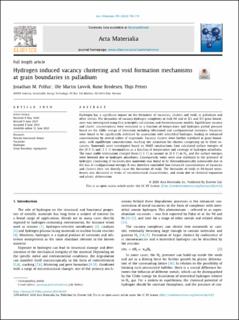| dc.contributor.author | Polfus, Jonathan Marc | |
| dc.contributor.author | Løvvik, Ole Martin | |
| dc.contributor.author | Bredesen, Rune | |
| dc.contributor.author | Peters, Thijs | |
| dc.date.accessioned | 2020-11-04T10:01:20Z | |
| dc.date.available | 2020-11-04T10:01:20Z | |
| dc.date.created | 2020-09-29T13:27:22Z | |
| dc.date.issued | 2020 | |
| dc.identifier.citation | Acta Materialia. 2020, 195 708-719. | en_US |
| dc.identifier.issn | 1359-6454 | |
| dc.identifier.uri | https://hdl.handle.net/11250/2686321 | |
| dc.description.abstract | Hydrogen has a significant impact on the formation of vacancies, clusters and voids in palladium and other metals. The formation of vacancy-hydrogen complexes in bulk Pd and at Σ3 and Σ5 grain boundaries was investigated using first-principles calculations and thermodynamic models. Equilibrium vacancy and cluster concentrations were evaluated as a function of temperature and hydrogen partial pressure based on the Gibbs energy of formation including vibrational and configurational entropies. Vacancies were found to be significantly stabilized by association with interstitial hydrogen, leading to enhanced concentrations by several orders of magnitude. Vacancy clusters were further stabilized at grain boundaries, with equilibrium concentrations reaching site saturation for clusters comprising up to three vacancies. Nanovoids were investigated based on Wulff constructions from calculated surface energies of the (0 0 1) and (1 1 1) terminations as a function of temperature and coverage of hydrogen adsorbates. The most stable termination changed from (1 1 1) in vacuum to (0 0 1) in H2, and the surface energies were lowered due to hydrogen adsorbates. Consequently, voids were also stabilized in the presence of hydrogen. Coalescing of vacancies into nanovoids was found to be thermodynamically unfavorable due to the loss of configurational entropy. It was therefore concluded that enhanced concentrations of vacancies and clusters does not directly cause the formation of voids. The formation of voids in Pd-based membranes was discussed in terms of microstructural characteristics, and strain due to chemical expansion and plastic deformation. | en_US |
| dc.language.iso | eng | en_US |
| dc.publisher | Elsevier | en_US |
| dc.rights | Navngivelse 4.0 Internasjonal | * |
| dc.rights.uri | http://creativecommons.org/licenses/by/4.0/deed.no | * |
| dc.subject | Grain boundary segregation | en_US |
| dc.subject | Hydrogen | en_US |
| dc.subject | Vacancies | en_US |
| dc.subject | Density functional theory | en_US |
| dc.title | Hydrogen Induced Vacancy Clustering and Void Formation Mechanisms at Grain Boundaries in Palladium | en_US |
| dc.type | Peer reviewed | en_US |
| dc.type | Journal article | en_US |
| dc.description.version | publishedVersion | en_US |
| dc.rights.holder | ©2020 Acta Materialia Inc. Published by Elsevier Ltd. This is an open access article under the CC BY license. (http://creativecommons.org/licenses/by/4.0/ ) | en_US |
| dc.source.pagenumber | 708-719 | en_US |
| dc.source.volume | 195 | en_US |
| dc.source.journal | Acta Materialia | en_US |
| dc.identifier.doi | 10.1016/j.actamat.2020.06.007 | |
| dc.identifier.cristin | 1834903 | |
| dc.relation.project | Notur/NorStore: NN2615K | en_US |
| dc.relation.project | Norges forskningsråd: 281824 | en_US |
| cristin.ispublished | true | |
| cristin.fulltext | original | |
| cristin.qualitycode | 2 | |

